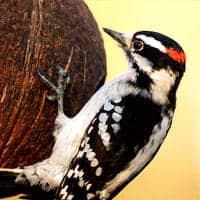 Woodpeckers are one of Gods amazing creatures, they are a very special family of birds found worldwide, except for Australia and New Zealand, Madagascar, and the extreme polar regions. Most species live in forests or woodland habitats, although a few species are known to live in treeless areas such as rocky hillsides and deserts.
Woodpeckers are one of Gods amazing creatures, they are a very special family of birds found worldwide, except for Australia and New Zealand, Madagascar, and the extreme polar regions. Most species live in forests or woodland habitats, although a few species are known to live in treeless areas such as rocky hillsides and deserts.
The diet of woodpeckers consists mainly of insects and their grubs taken from living and dead trees, along with fruit, nuts and sap from live trees. Their role ecologically is geared towards keeping trees healthy by keeping them from suffering mass infestations. The family is noted for its ability to acquire wood-boring grubs using their bills for hammering, but overall the family is characterized by its dietary flexibility, with many species being both highly omnivorous and opportunistic.
What’s so special about the Woodpecker?
Many of the foraging, breeding and signaling behaviors of woodpeckers involve drumming and hammering using the bill. To prevent brain damage from the rapid and repeated decelerations, woodpeckers have a number of special features built in for its protection. These include small brain size, the orientation of the brain within the skull (which maximizes the area of contact between the brain and the skull) and the short duration of contact. The millisecond before contact with wood a thickened nictitans membrane closes, protecting the eye from flying debris. The nostrils are also protected; they are often slit-like and have special feathers to cover them.

Downy Woodpecker - Picoides Pubescens by Ed Gaillard - The smallest woodpecker in North America (cc)
The Woodpecker creates a major problem for the evolutionist because they cannot explain how this bird has the ability to not only know that their is delicious food in trees, but also has all the necessary equipment to extract it. The equipments of the woodpecker needs a lot of explanation, because they allows the woodpecker to complete some miraculous task! The woodpecker unlike many birds has two toes out in front and two toes out in the back of its feet, allowing the bird to climb around trees like an expert, it can climb right side up, upside down, or even sideways, it uses its tail to help as a tripod against the tree, the special feathers absorb some of the shock, from the blows of the woodpeckers head against the trees. The tail of the woodpecker is much more resilient than that of other birds. The woodpecker has another incredible shock absorber between its beak and its skull, tough elastic cartilage prevents severe headaches from the constant pounding on trees all day.

Pileated Woodpecker - Dryocopus Pileatus by North60 - Considered to be the second largest woodpecker species in the world. The largest is the Imperial Woodpecker thought to be extinct. (cc)
The skull bones of the woodpecker are the sturdiest bones, per body weight, of any animal. Brain surgeons study the ways a woodpecker’s brain is attached to its skull to help them learn how to reattach human cranial tissue after severe trauma – Dr. Jobe Martin, The Creation Book
Woodpeckers has long sticky tongues for extracting food. Most birds has tongues that extend just beyond the tip of their beak, but the woodpecker’s extend as far as…..ten inches! Their tongues are in a class of its own, its long enough to probe tunnels in trees for insects, the tip has a number of barbs or hairs pointing rearward, which helps the woodpecker to secure the insects while transporting it back to the beak, a sticky glue-like substance also coats the tongue to aid in the process. In some woodpeckers the tongue exits the skull through a small hole between the eyes and enters the beak through one of its nostrils, think that’s is amazing? The European green woodpecker’s tongue goes down the throat, out the back of the neck “around the back of the skull beneath the skin, and over the top between the eyes, terminating usually just below the eye socket”!
Green Woodpecker - Picus Viridis by Greg Marshall (cc)
How could this bird evolve? and where are its ancestors or missing links? The evolutionary history of this group of birds is not well documented, evolutionist cannot explain where it inherited its special beak, feet, tail feathers, shock absorbing cartilage, thick skull, unique tongue and eye protection, etc. What a fascinating creation! the woodpecker was designed to carry out specific task geared towards its survival. The Woodpecker displays the wonderful and glorious evidence of a Creator God who has the ability to create a specie that defies any theory that would leave God out of the picture. God says that if we carefully study what He has made, we will either honor Him as God and give him thanks, or be reduced to foolish speculations.
“since what may be known about God is plain to them, because God has made it plain to them. For since the creation of the world God’s invisible qualities—his eternal power and divine nature—have been clearly seen, being understood from what has been made, so that people are without excuse. For although they knew God, they neither glorified him as God nor gave thanks to him, but their thinking became futile and their foolish hearts were darkened. Although they claimed to be wise, they became fools..” Romans 1:19-22
Reference: Wikipedia: Woodpecker | The Creation Book, Dr. Jobe Martin



2 thoughts on “Creation Tidbits – The Woodpecker”
Love it. Thanks for this info. The woodpecker is an amazing bird.
You are welcome, happy like information about the woodpecker, God Bless 🙂